I had been planning to write about butter tarts for a while, but things got away from me. There was some Covid, bloody visits to urgent care, broken washing machines, septic systems in meltdown, and egregiously early school start dates. (I think all good food writing mentions injury and plumbing. You?)
When I emerged from that quagmire, however, I realized that today marks the thirteenth anniversary of my move from Canada, where I was born, to the United States, where I live. So it all works out, I guess, because I got to bake some butter tarts for my expat-iversary.
Conspicuously absent south of the border, butter tarts were everywhere when I was growing up. No church basement, backyard barbecue, or Grey Cup party was without them. Sometimes they were homemade. More often, they were half homemade with a store-bought tart shell. Most often of all, though, they came in a plastic grocery store clamshell, cracked open and plonked on a table with little ceremony but much appreciation.
If you’re not in butter tart country, you might think of them kind of like a chocolate chip cookie. They’re not an exceptional addition. They kind of show up everywhere. But you would probably miss them if they disappeared from all dessert spreads.
For the uninitiated, a butter tart is a small sugar pie. It's a mix of sugar and/or corn syrup, egg, and butter baked into a small flaky tart shell. Some points of comparison that might give you an idea are pecan pie, raisin pie, chess pie, or tarte au sucre.
Like the inside of a butter tart itself, however, the origins and conventions of this tiny Canuck treat are quite sticky. No one agrees where they came from—did they travel from Europe or did Canadians invent them? Nor do Canadians seem to agree upon how to make them. Should they be runny or firm? Filled with raisins, nuts, or nothing?1
The only point of agreement seems to be that the first mention of butter tarts that anyone has yet found shows up in The Women’s Auxiliary of the Royal Victoria Hospital Cookbook in 1900.2 By 1910, they had taken off in rural Ontario, and by 1913, with the printing of the Five Roses Cook Book (Five Roses is a brand of flour), they became popular across the Dominion of Canada.3
After that, it seems, butter tarts branched out and controversy emerged. So what did early butter tart recipes look like? How have they changed? And is my grandma’s the best?
The History of the Butter Tart in a Series of Cookbooks Unscientifically Chosen by my Mother, at Random, in Thrift Stores
Recently, I returned from a sabbatical in a small Ontario historical cookbook collection, also known as my mom’s apartment. I pulled every recipe for a butter tart I could find in a fun little exploration of the tart’s evolution.
As I noted above, the Five Roses Cook Book, was immensely popular in the early twentieth century, setting off the butter tart craze in Canada. This early tart recipe calls for one full cup of currants and little other than brown sugar, egg, and bit of butter. It was probably a rather fruit-heavy version, giving support to the notion that the dried fruit iteration of the butter tart—versus the nut or plain versions—is close to the original. There is even an option of adding more fruit in the form of a cup of dates. Indeed, it probably was mostly a firm, dried-fruit confection early on.
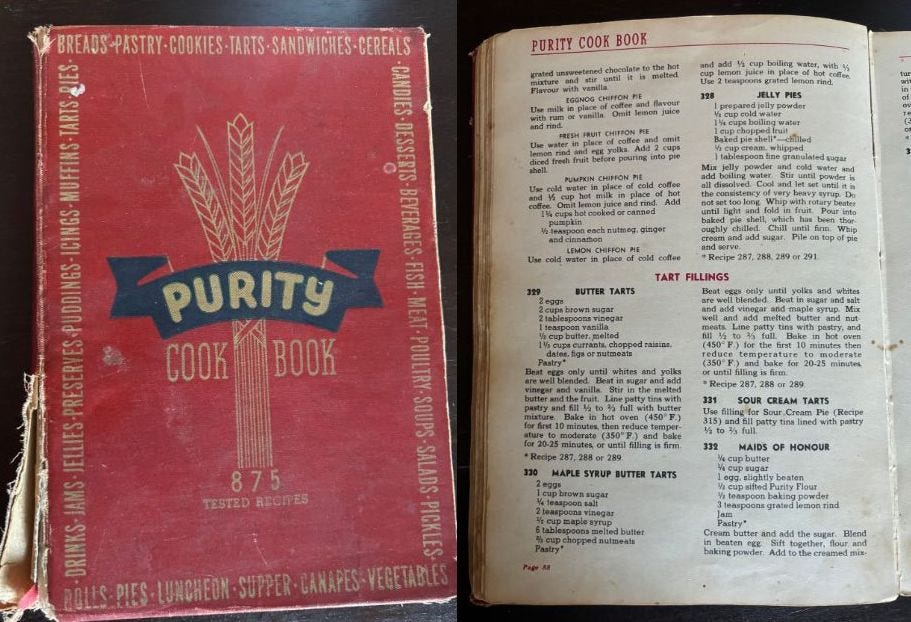
Though similar to Five Roses butter tart, the Purity Cookbook butter tart includes less dried fruit for the amount of filling and adds some vinegar. Notably, while Five Roses suggests only currants and dates, it seems that people were playing with fillings by the 1930s. Currants, raisins, dates, figs, and nutmeats are all suggested additions. (Purity is another flour brand.)

Canadian Cook Book and its author, Nellie Lyle Pattinson, have their own fascinating history. First published in 1923, the edition pictured above is a revised 1953 version in a later printing.
The original 1920s butter tart recipe, as you can see here, is almost the same as the 1950s version. Interestingly, it uses plain sugar instead of brown, something I’ve only seen in this book, and that seems rather atypical. It would probably give the tart a pale color, instead of its signature dark brown.
There are slight differences in this newer edition, however. It offers the option of either one egg or two instead of the two called for in the original, and also gives the choice of swapping some sugar for corn syrup. Mid-century, then, is when corn syrup and the runny butter tart seem to enter the discussion.
(Was this linked to Karo’s successful pecan pie marketing drive in the 1930s? That would be my guess, but I don’t know.)
Chatelaine is an old Canadian women’s magazine, and this is a version of the butter tart from their 1965 cookbook. This mini-pie from the time of Pearson hails from Saskatchewan. It has adopted a little touch of corn syrup, and it has a mix of both walnuts and raisins. The corn syrup is starting to flow, entering the butter tart canon.
The Five Roses cookbook from the 1970s does not succumb to the corn syrup craze, but it also is not a carbon copy of the august World-War-I-era Five Roses tart. It adds some liquid in the form of milk. The milk is in contrast to the other tarts above, which use vinegar or lemon juice as a liquid addition.
On top of that, it reduces the amount of mix-ins called for in the 1915 version—from 1 to 1/2 cup—and offers the option of raisins or pecans instead of currants. It standardizes the amount of butter, going from walnut-sized to 1/3 cup, and specifies to add vanilla, instead of the vague “flavor [sic!] to taste.” So the tart has become at least a little bit less firm and fruit heavy, but it is not a runny tart.
Here is another 1970s or 80s tart, but this one goes all in on the corn syrup (one cup!) and also offers the option of margarine. Sounds like we’re at least getting close to the 80s to me!
These tarts sound big and runny, but stick to the tradition of using only raisins.
And my family’s butter tart recipe? Here is one from my maternal grandma, who immigrated to Canada from Ireland in her teens, written out on a cue card by my mom.
What do you know, it is the exact recipe from Five Roses ca. 1970s, that all-time classic.
The Great Canerican Butter Tart Bakeoff!
I will confess that, growing up, I wanted nothing but a plain butter tart. Finding raisins or nuts in that sweet, gloopy morass was a real heartbreaker for me. I had no strong opinions on runny versus firm, though. Don’t get me wrong, I love dipping flaky crust in butter tart goo, but I would never say no to a firm tart either.
But nostalgia is a funny thing, and when I sat down to pick a recipe, I found that I wanted—no, I needed—it to have raisins.
I also needed it not to have corn syrup, simply because I did not have corn syrup on hand. Also, I think a corn-syrup-free, raisin-filled butter tart comes closest to its early form.
I chose, of course, the recipe my grandma and mom use, and I also decided to make the New York Times butter tart recipe from 2018. It’s new, it’s flashy, it’s ostensibly updated, and, yes, it’s from an American source, but I’m a dual citizen now. (I used a Canadian Living recipe years ago I didn’t love, so I didn’t go with that one.)
Of note: I used the pastry recipe from the Times for both. And I will say, it was an absolute dream to work with. Pastry and I often have disagreements, but this one came together quickly and easily, it was wonderful to work with, it baked up beautifully, and it released from the muffin pan easily.
There are very slight differences in these butter tarts. First, they bake differently. NYT bakes at a steady temperature through, Roses bakes hot at first and then moderate. Second, Roses has double the amount of raisins. Third, NYT has more salt and no milk.
The Roses tarts bubbled up and overflowed a bit, though I do bake at altitude, which often messes with things. The NYT tarts came out beautiful and neat, the Roses tarts a bit more shaggy and homespun.
And the winner? While they are both delicious, our house liked my grandma’s more. They tasted perfect to me—maybe a given—but my American husband chose them in a blind taste test, too.
I think it comes down to the very paltry amount of raisins in the Times tart. If you’re going to go raisin, I say go all in.
Happy Anniversary to me!
If you want to wade into the controversy, be my guest, but enter at your own peril; it’s silly in there: https://www.readersdigest.ca/culture/surprising-history-butter-tarts/; https://www.cbc.ca/player/play/video/1.4411242; https://www.readersdigest.ca/culture/surprising-history-butter-tarts/.
https://www.thecanadianencyclopedia.ca/en/article/butter-tarts
https://www.nytimes.com/2018/01/12/dining/butter-tarts-canada.html





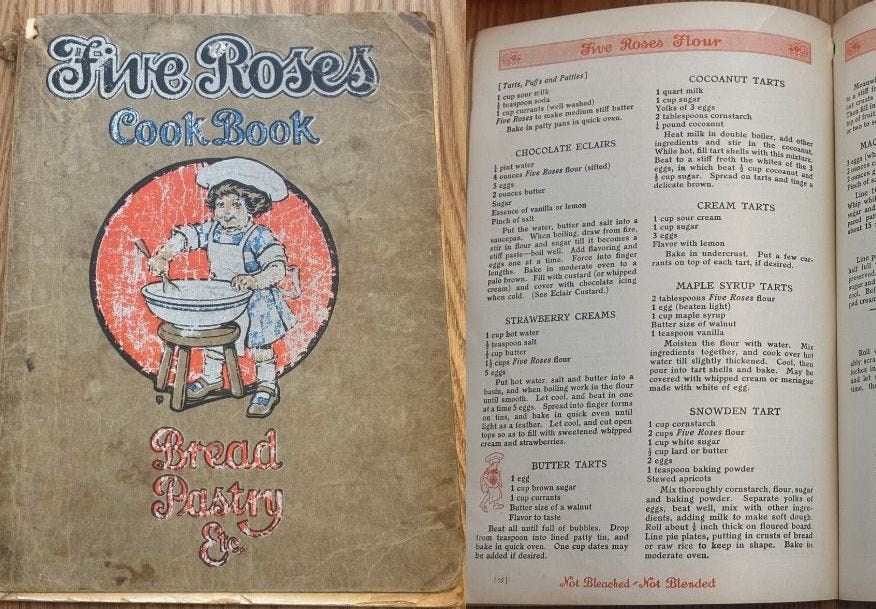
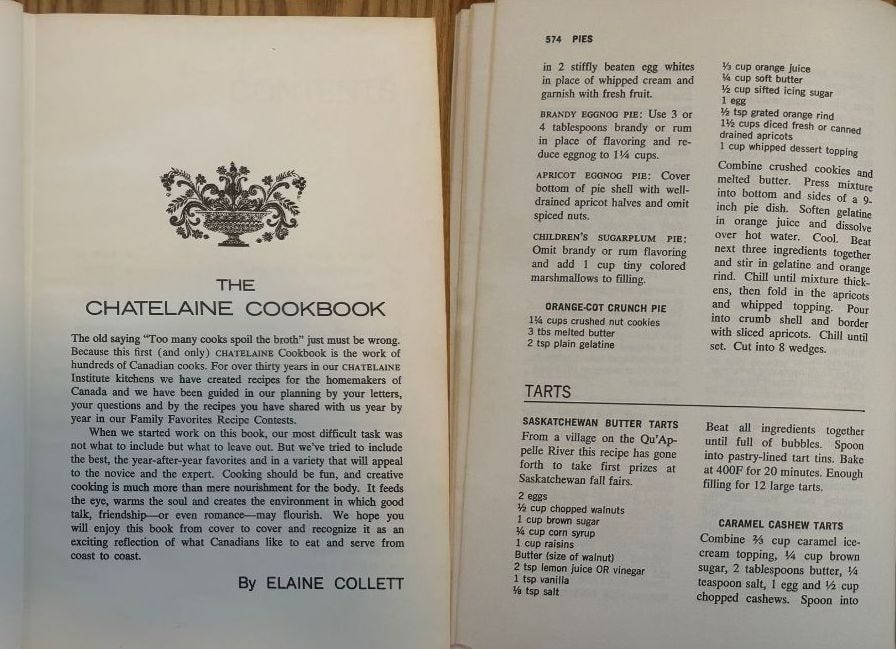
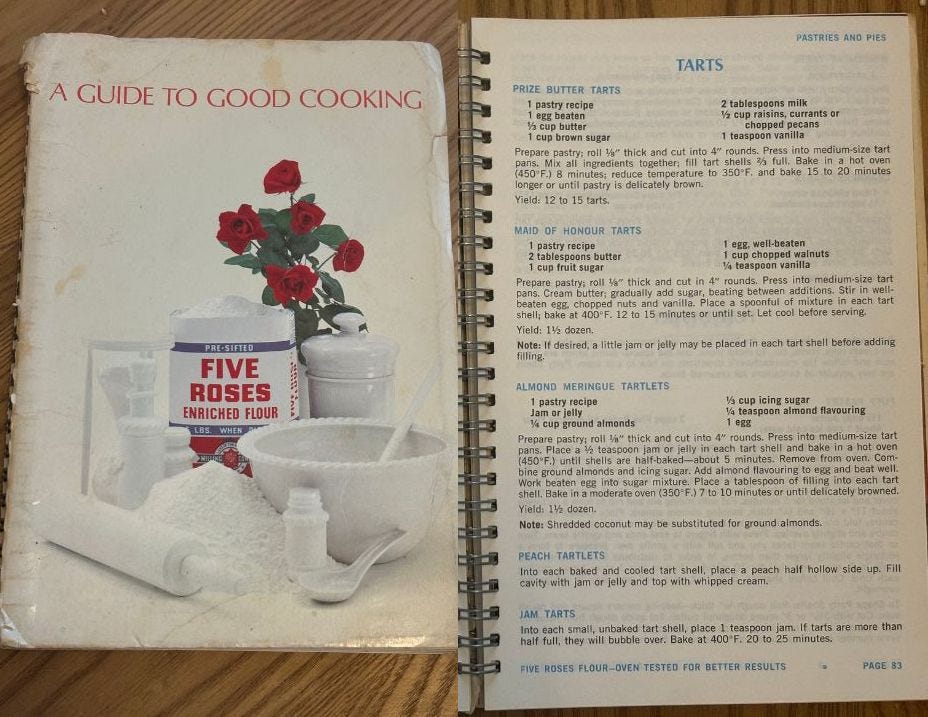
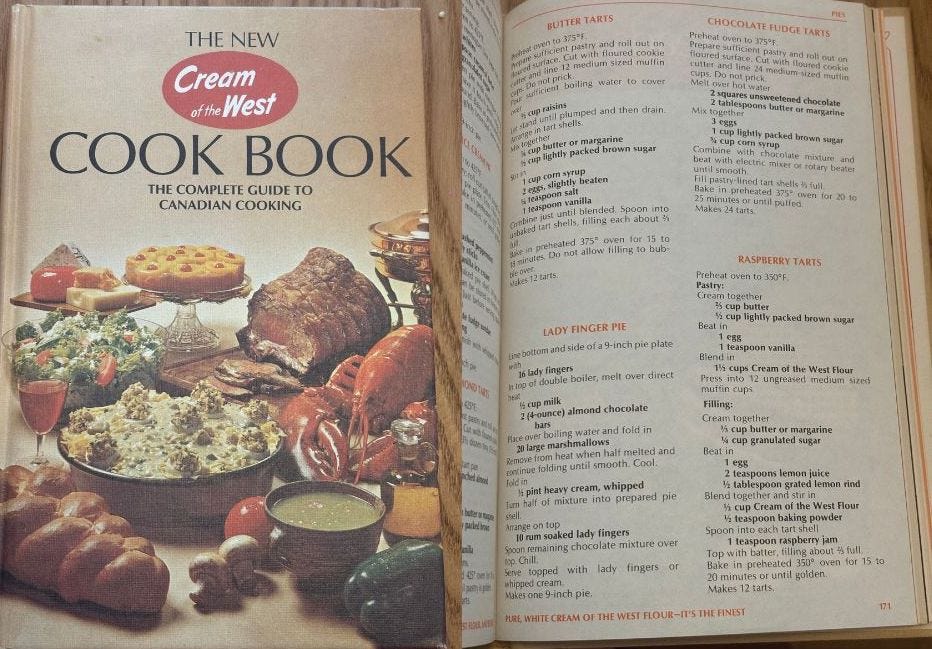
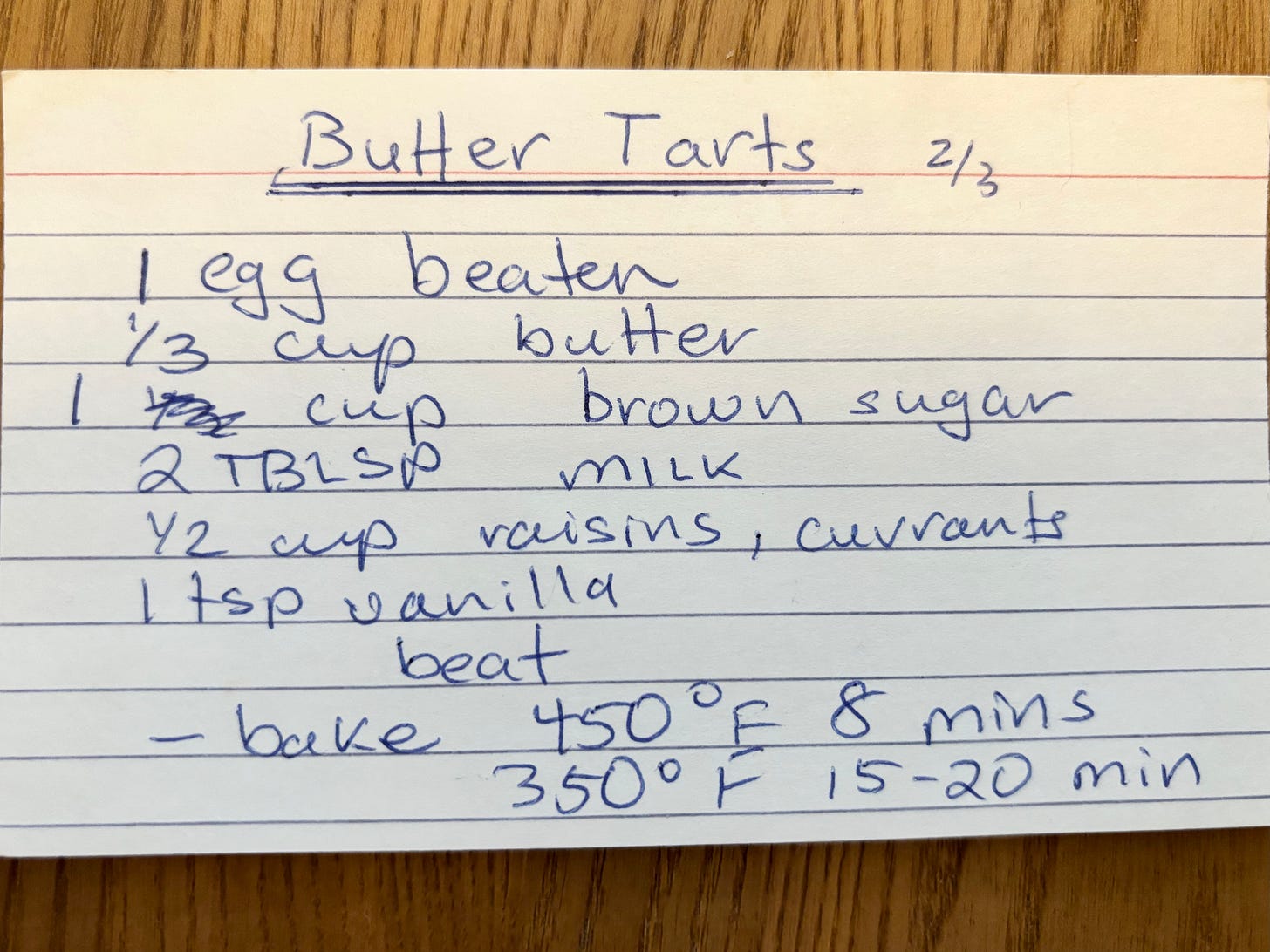

I completely agree about the nuts in the butter tarts, just no. A few raisins is acceptable. I’ve been wanting to make butter tarts the way my mum used to make them and I keep looking for the right recipe. Now I think I might have found it! Thank you for this!
Hi Robynne. Hoping you can help! I'm desperately looking for a Butter Tart recipe from the Chatelaine cookbook by Elaine Collette (the one that you show above). But it wasn't the Saskatchewan recipe; as I recall, it called for a small amount of sour cream to cut back the sweetness and make the filling more firm. I lost my cookbook in a recent move.